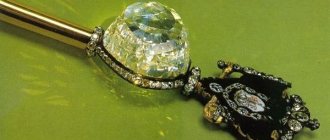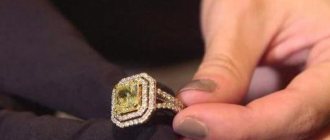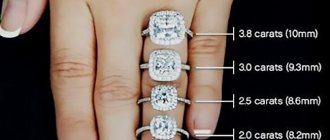The one and only diamond “Shah”
The history of the Shah diamond begins in the mid-16th century.
from the mines of the Islamic Golconda Sultanate. For reference: Diamond is distinguished from other precious stones by inscriptions on the edges made by owners in different eras.
View this post on Instagram
Posted by Afalina (@afalina_afalina) Apr 18, 2021 at 8:17 am PDT
Having traveled a journey of more than 5 centuries, the unusually shaped diamond was not lost, it was carefully stored and passed on to other owners for various, but often bloody reasons.
What is the Shah diamond?
The most important characteristics of a gemstone are its size and clarity. From this point of view, "Shah" is an outstanding crystal:
- currently weighs approximately 88.7 carats;
- transparency is almost perfect, there are no dark inclusions in the stone;
- yellowish color, with a slight admixture of reddish-brown;
- there is no cut, the diamond was only polished, which increased its natural shine;
- elongated shape, in the form of an asymmetric octahedron with 15 rounded edges;
- on three sides there is an engraving in the form of inscriptions;
- A circular groove was made at one end for hanging the stone.
During a detailed study carried out about a hundred years ago by academician M. Fersman, it was discovered that the surface of the crystal is covered with a network of tiny cracks, because of which, from the point of view of jewelry, it cannot be considered flawless. However, not only the material, but also the historical value of the stone, which over the course of several centuries has repeatedly changed owners and host countries, is important to us.
Characteristics of the Shah diamond
The treasure of the Diamond Fund of Russia, the Shah crystal has changed several rulers . The stone is 3 cm long, 1.5 cm wide, in the shape of an elongated octahedron. The weight of the 87-carat Shah diamond is 18 grams; before polishing it weighed 95 carats.
The uncut crystal was polished, and the owners engraved their names on it. It has a surrounding groove for a cord that was attached to the canopy of the Shah's throne.
A detailed description of the diamond was given by Professor Alexander Fersman, a mineralogist and crystallographer. In 1922, the scientist studied and characterized the jewelry of the Armory Chamber.
Interestingly, the octahedron is the shape of the classic diamond. When processed, it is divided into 2 parts along the middle fracture, and the 5-sided pyramids familiar in cross-section are obtained.
For reference: Unlike a classic diamond, the “Shah” has an oblong shape with rounded edges - in the schematic image it is a long diamond-shaped prism, the ends of which are blunt and look like pyramidal planes (domatic).
There are no typical middle breaks. Fersman identified 15 facets on the stone, 8 of which are natural, the rest from manual processing.
The ideal transparency of a diamond contributes to the shimmer of light and the play of all colors of the spectrum .
The professor noted a yellowish tint, which is due to the structure of the surface layer. The diamond layers are cut through by scaly plates, reflected on the facets by thin arcs, as well as internal microcracks.
The fate of jewelry in the twentieth century
After the revolution and civil war, the treasure was not lost; it was taken to Moscow along with the rest of the jewelry. “Orlov” and other famous gems were also there. In 1922, the stone was re-examined by A.E. Fersman, who measured the angles of the faces, carefully studied the inscriptions, as well as the sculpture of the crystal.
Many rare diamonds were sold off in the 20s of the twentieth century, for example, this fate befell the famous Sancy diamond. But “Orlov” and “Shah” were miraculously preserved during these troubled times, and now these stones are on public display in the Kremlin.
_______________________________________
* “Orlov” is a large diamond in the imperial scepter, the largest in the collection of the Diamond Fund of Russia. It is believed that this huge diamond was given to Catherine II by her favorite Count Orlov, who returned from a trip to Europe. According to another, less common version, it is believed that the empress herself purchased the diamond, and the “gift” became a beautiful and romantic legend to hide the huge expenses on jewelry.[back]
Origin of the diamond
A stone of an unusual shape was found in the Golconda mines, located in Central India, in the middle of the 16th century. But according to the records of the French merchant and traveler Jean Baptiste Tavernier, it is known that the Golconda mines were developed during his trips, that is, in the middle of the 17th century, 1630–1660.
Taking as truth the statement of a famous traveler and a person associated with Indian precious stones, we can assume that “Shah” was found in another mine in gem-rich India.
Who owned the Finger of Allah diamond?
The main historical periods of diamond:
- from the middle of the 16th century to 1591 - Burhan II, Sultan of the province of Ahmednagar, India;
- from 1595 to 1739 - dynastic treasure of the Great Mughals;
- from 1739 to 1829 – kept by the padishahs of Persia;
- from 1829 to 1917 - the relic is transferred to the treasury of the Romanov imperial family;
- from 1917 to 1922 – the Moscow Kremlin, the jewel of the Soviet state;
- from 1922 to the present - one of the exhibits among the large precious stones of the Diamond Fund of the Moscow Kremlin.
Since ancient times, diamonds have been valued for their hardness, purity, and endow the owner with intelligence, courage and determination. But the yellowish diamond found in Golconda, due to the prejudices of the Indian rulers, was not in favor and was sold for a small price to the Ahmednagar Sultanate in the south of the Hindustan Peninsula.
The Muslim ruler Burhan II appreciated the diamond for its shape and attractive shine, and considered the color to be good luck, and named it “Finger of Allah.”
Relic of the Mughal dynasty
The second owner becomes Akbar , the third padishah of the Mughal Empire, grandson of the founder of the dynasty Babur. The ruler's conquests significantly expanded the borders, which included the northern and central regions of India.
In 1595, Baburid conquered the province of Burhan II. The “Finger of Allah” diamond passes to him and becomes another relic of the untold wealth of the Mughal dynasty.
Half a century later, Shah Jihan, Akbar's grandson, sets his sights on the diamond , having ascended to the throne after a series of bloody uprisings against his own father.
Khan became a ruler who went down in history not only by expanding his borders. One of his unique legacies has survived to this day and has become the adornment of India. This is the Taj Mahal mausoleum, dedicated to his beloved wife Mumtaz Mahal.
In 1658, Alamgir I, or Aurangzeb, the son of Shah Jihan, took over the dynastic rule of the empire.
In 1665, Jean Baptiste Tavernier visited him. The inventory of wealth and treasures he compiled mentions a throne made of pure gold under a canopy, inlaid with multi-colored stones, enamel and with figurines of peacocks.
Placers of jewels sparkled on the feathers of birds . Their flowing tails served as the backrest of the throne. The canopy was decorated with stones.
Among them there was also a place for the “Finger of Allah”, suspended on a cord of gold or silk threads, so that the ruler could see the diamond in all the splendor of sparkling and iridescence.
It was for the suspension that a circular groove was drawn.
The Peacock Throne was created during the life of Shah Jihan.
But Tavernier’s descriptions and the images of the ruler sitting on the throne that have survived to this day indicate that the merchant, blinded by the imperial splendor, could have described him incorrectly.
Portraits indicate that peacocks decorate the canopy, but the back is missing.
Diamond history
Shah Diamond
The famous “Shah”, like the Hope Diamond, “Orlov” and most of the largest antique diamonds come from India, as do most of the world’s most famous diamonds. “Orlov” differed from its Indian counterpart in having a “lighter” reputation, which cannot be said about “Shah,” whose entire history is rich in bloody events. Contrary to Indian traditions, it has not 6, 8 or 12 sides, but 15, its shape is far from ideal, and its color is not white . Such a diamond did not seem outstanding to the Indians, and they sold it to the Sultan of Ahmednagar, a state in the west of Hindustan.
The ruler of Ahmedagar was Burkhan the Second, who was a devout Muslim. He cared little about Hindu beliefs regarding stones, and a large diamond, similar to a finger, seemed to him to be the ideal creation of Allah. The name of Burhan the Second was the first of three engraved on the smooth surface of the stone.
On topic: An uncut diamond is made into a diamond
The court master figured out to engrave an inscription on the hard surface of the diamond using another diamond, since no other substance in the world could scratch the stone. Taking diamond chips onto the thin tip of a needle, lubricated with oil, the master carefully scratched out the name of the Sultan. The inscription, the result of long and painstaking work, reads: “Burkhan the Second Nizam Shah. 1000 year" . In terms of European chronology, it was 1591, which allows us to accurately calculate the age of the “Shah” - 425 years.
The “Shah” did not stay with the Sultan for long - four years later, Ahmadnagar was conquered by warlike neighbors - the Great Mughals. Akbar, a descendant of Tamerlane, appropriated the famous diamond for himself along with many other jewelry.
The stone would have gathered dust in the treasury for a long time if 40 years later it had not caught the eye of Jihan Shah, the grandson of Akbar, who was also a good lapidary. He cut many gems with his own hands. According to some experts, the polishing of the Shah diamond was also his doing. At the behest of Jihan Shah, the diamond was decorated with a new inscription that read: “Son of Jihangir Shah Jihan Shah, 1051.” The year was 1641.
The second inscription differs from the first in greater skill and beauty. The fate of Jihan Shah was not so beautiful; he died as a prisoner in the Agrin fortress in 1666, overthrown by his own son Alamgir. Later he will be known to the world under the name Aurang-Zeb.
Before being lost for 150 years, "The Shah" was described in 1665 by the Frenchman Jean Baptiste Tavernier. The merchant described in detail many famous Indian diamonds and the decoration of the Shah's palace. The diamond was part of the "Peacock Throne", it hung on a silk thread from the canopy, and the throne itself was decorated with hundreds of precious stones - rubies, sapphires and emeralds of the best quality.
Topic: How diamonds are mined
Later, the famous diamond appeared in Iran. The diamond entered the treasury when Nadir Shah, the ruler of Iran, conquered Northern India. In 1747, the Shah was stabbed to death by conspirators, and civil strife began in Iran. The next Shah was the founder of the new Qajar dynasty, Agha Muhammad Khan. Since the new ruler was a eunuch, he appointed his nephew, known in the future under the name of Fath Ali Shah, as his successor. At his order, a third inscription was made on the diamond in honor of the anniversary of his reign.
"The Qajar Lord Fath Ali Shah Sultan, 1242." The engraving was made in 1824.
Diamond goes to the Persians
By 1739, tiny provinces remained of the Indian territories over which the Great Mughals reigned supreme. The Persian commander Nadir Shah reduced the areas of the state by sacking Delhi and seizing lands west of the Indus River (Sindh, Peshawar and Kabul).
It was he who took away the Peacock Throne and the Mughal treasury along with the Finger of Allah and Koh-i-Noor diamonds . The treasures of the Baburids were taken out on 21 camels: about 2 tons of gold, about 5 tons of diamonds, priceless emeralds and rubies. The pearls were loaded into the caravan without being counted or weighed.
In Persia, the trace of the Peacock Throne was lost with the death of Nadir Shah in 1747. Some claim that the relic was captured by the Kurds, dismantled and sold, other sources write that its parts were used to make Persian “peacock” thrones.
Unlucky Stone
Like any priceless treasure, the world-famous diamond is followed by a long list of bloody events. The history of "Shah" is replete with the tragic deaths of its owners. This has led some researchers to claim that the stone brings bad luck. Moreover, the yellowish tint makes it look like the eye of a tiger, and this, according to Indian beliefs, is extremely dangerous.
The famous writer and publicist Nikolai Nepomnyashchy in his book “100 Great Secrets of the East” listed the misfortunes that befell many diamond owners. Thus, the ruler of the Ahmadnagar Sultanate, Burhan II, was killed in 1595, when his country was captured by Shah Akbar of the Mughal dynasty.
The winner took the loser's jewelry for himself, and 10 years later died while hunting. His grandson Jehan Shah, who engraved his own name on the diamond, was dethroned and strangled on the orders of his own son Aurang Zeb, who also died under strange circumstances. The ruler of Delhi was allegedly poisoned.
In 1739, the capital of the Mughals was captured by the Iranian military leader Nadir Shah, who was very interested in the Indian treasury. Among the trophies taken away was the famous diamond. In 1747, the new owner of the Shah was stabbed to death by conspirators. Following this, a bloody struggle for the throne began, during which the stone passed from hand to hand. The last Iranian owner of the artifact, Feth Ali Shah, lost the war with Russia, and after the death of A.S. Griboyedov was forced to part with his treasure.
“Finger of Allah”: the price for the death of ambassador and writer A.S. Griboyedova
On January 30, 1829, in Tehran, religious fanatics destroyed the representative office of the Russian
empires.
During the attack, a talented diplomat and ambassador, writer Alexander Griboyedov was killed. One person survived from the mission.
It is interesting that the story of Khozrev Mirza, the padishah’s heir, presenting Emperor Nicholas I with a rare diamond from the Baburid dynasty as a sign of apology and compensation for the death of the writer appeared after the publication of Yuri Tynyanov’s novel “The Death of Wazir-Mukhtar” (1927–1928 edition).
The Russian autocrat did not ask for any money or diamonds for the death of Griboyedov, but demanded recognition of guilt and repentance for the murder of representatives. In the spring of 1829, the Prince of Persia visited Emperor Nicholas I. The purpose of the visit was to reduce the indemnity under the Turkmanchay Treaty of 1828.
The padishah's court was able to collect only 8 of the declared 10 kururs of recovery, which amounted to about 20 million rubles. Abbas Mirza decided to fill the missing amount with the “Finger of Allah” diamond, ancient manuscripts, carpets, precious stones, and horses. The Emperor forgave Persia the remainder of the payment and even presented the diplomatic mission with royal gifts.
“Shah” to the Russian Tsar, or “Unfortunate Incident” in Tehran
A. S. Griboyedov, head of the Russian diplomatic mission in Tehran. Lifetime portrait by P. A. Karatygin
The tortured body of the Russian ambassador was identified with difficulty - by the characteristic trace of a wound, a memo about that ill-fated duel in 1818 in Tiflis with ensign of the Nizhny Novgorod Dragoon Regiment Alexander Yakubovich. A long-standing story that shook the capital is the famous quadruple duel over the ballerina Istomina. After the shot by Yakubovich, the recently brilliant cornet of the Life Guards Uhlan Regiment, now transferred to the Caucasus, Alexander Sergeevich Griboyedov could no longer play music - his left hand was damaged by a bullet. But it was only thanks to this mark that the hacked and stoned body could be identified. News of the tragic incident in Tehran reached St. Petersburg on March 4, 1828. The unsteady and short-lived peace between Russia and Persia began to waver. Everyone was waiting for the reaction of the young Emperor Nicholas I, who was not prone to sentimentality. However, contrary to authoritative court rumors, war did not happen.
In the shadow of the great enemy
For several centuries, the main one in the southern direction of Russia's foreign policy was the Ottoman Empire - a large and restless neighbor, the source of numerous wars and fragile peace treaties. However, the Sublime Porte was by no means the only subject of Russian politics in the Middle East. The young metropolitan Petersburg shared the border in the South Caucasus with ancient Tehran, which easily created problems for both Russians and Turks.
Relations between the two countries at the beginning of the 19th century. were already long and difficult. Their roots went back to the 16th century, when forests and swamps were located on the site of the future Northern Palmyra. During the reign of Ivan IV, the conquest of the Astrakhan Khanate was completed, and Moscow gained access to the Caspian Sea, a water basin connecting East and West with trade ties. In the first half of the 17th century, Russia began to establish itself in the North Caucasus, building fortresses and fortresses there. Such actions were already closely affecting the traditional influence of the Persian shahs in this region, and, of course, they could not look at what was happening with the notorious eastern calm. Initially, the struggle was waged for influence on the local mountain tribes, the loyalty of certain leaders and small khans.
Russia made its first serious attack on Persia at the end of the reign of Peter I, when, after the end of the Northern War, the Russian emperor decided to organize a military expedition to the western coast of the Caspian Sea. The reason was the unstable internal situation in Persia and attacks on Russian merchants committed by Lezgins who rebelled against the Shah's power under the leadership of Daud Beg. Formally, the campaign was not directed against Persia as such, but to restore order in the lands bordering Russia. In fact, Peter I planned to take control of several geographically important cities, which would help Russia trade with Central Asia, and through it with India. At first the operation progressed quite well. A large transport flotilla of almost three hundred units, with about 22 thousand infantry on board, entered the Caspian Sea and headed towards the Gulf of Agrakhan. Regular and irregular cavalry were sent there from Tsaritsyn. Formally, the expedition was commanded by Admiral General Apraksin, but the actual leadership was carried out by Peter himself.
On July 27, 1722, on the day of the Gangut victory, Russian troops landed on the shore, and a month later they occupied Derbent. The elements intervened in the further course of the expedition - a strong storm in the Caspian Sea thoroughly battered the transport flotilla, sinking some of the ships with food. The emperor was forced to return to the north, and a garrison was stationed in Derbent. This was, by the way, the last military campaign with the participation of Peter I. The next year, a new campaign took place in the Caspian lands, but with much smaller forces and without the participation of Peter. Baku was occupied by a Russian detachment. Finding itself in a difficult situation not only due to the actions of its northern neighbor, but also due to the outbreak of war with the Ottoman Empire, Persia was forced to conclude a peace treaty with Russia in October 1723, according to which the cities of Derbent, Baku, Rasht and some other territories.
However, these acquisitions were not in the possession of St. Petersburg for long. In 1733–1734, another government crisis broke out in the fading Polish-Lithuanian Commonwealth, and Russia sent troops there to prevent Stanislaw Leszczynski from seizing the Polish throne. The Ottoman Porte, seeing this political act as a threat to its own interests, began preparations for war. Empress Anna Ioannovna was forced to preoccupy herself with finding allies, and it turned out that Persia, which was waging another war with the Turks at that time, was most optimally suited for this role. And, in order to make the negotiating partner more accommodating, the Persian side was offered a deal: Russia renounces its Caspian possessions and returns them to the Persians in exchange for a commitment to a joint alliance against Turkey. During 1734–1739 Russian troops were withdrawn from all Persian territories.
During the reign of Elizabeth Petrovna, in the late 40s. XVIII century, it became known that “enlightened sailors” began to show suspicious activity in the Caspian Sea basin. England by this time had developed trade with Persia and began to seriously think about organizing the Persian fleet in this water basin - it began building two ships. Chancellor Bestuzhev, who concentrated all the threads of Russian foreign policy in his hands, received information that these ships would defend not so much Persian as British interests in the Caspian Sea, since they would be commanded by British officers. Russia could not afford the appearance in this region of any other naval forces other than its own. And therefore Elizaveta Petrovna demanded that appropriate measures be taken. In the fall of 1752, Bestuzhev reported to the Empress the results of the special operation: naval officers and servicemen sent from Astrakhan secretly entered Persian territory and burned both ships that were so interfering with Russian interests. Participants in this action received promotions and monetary rewards. This was the end of the English adventure with the creation of a pocket fleet in the Caspian Sea.
The next serious military clash between Russia and Persia occurred already at the beginning of the 19th century, during the reign of Alexander I. All of Europe, to one degree or another, was drawn into the era of the Napoleonic Wars, and the Middle East became an arena for clashes between opposing coalitions. Alexander’s father Pavel Petrovich had the misfortune of being completely disappointed in his “Western partners” - England and Austria - and seriously hatched plans for a Russian-French military alliance. Ataman of the Don Army Matvey Platov, at the head of a large cavalry detachment, was sent on the Indian campaign. Realizing the full depth of the possible consequences of such a development of events, enlightened sailors began to act. Pavel Petrovich suddenly died from an “apoplectic stroke” caused by an unusually strong silk scarf around his neck, and an urgently sent courier returned the expedition, which was already in the Kyrgyz steppes, home. Russia's sudden impulse in eastern politics was stopped, its energy was redirected to the fight against Napoleon.
Among the many new decrees and resolutions of the new emperor was a Manifesto on the establishment of a new government in Georgia, the Georgian province was formed. In 1803, Mingrelia was annexed to the Russian Empire. Such steps were perceived painfully in Persia, and in June 1804, Shah Feth-Ali declared war on Russia, eloquently promising to “expel the Russians from Georgia, slaughter and exterminate.” However, it turned out that this event was somewhat more difficult to implement than to proclaim. The Russian-Persian War lasted intermittently until 1813.
During this time, the battles of Preussisch-Eylau and Friedland died down, and the Peace of Tilsit was concluded. After it, another Russian-Turkish war began, and English instructors appeared in the Persian army. The sons of Foggy Albion continued to train the Shah's soldiers even when the battalions of the Great Army crossed the Neman and moved towards Moscow. Nevertheless, the Russian command managed to restrain the Persian fervor in expelling outsiders from Georgia with very limited ground forces, assisted by ships of the Caspian flotilla. On January 1, 1813, as a result of a merciless and bloody assault, the Lankaran fortress was taken, its entire garrison of more than three thousand people was destroyed. The detachment of General Kotlyarovsky storming it lost almost a thousand people killed and wounded. The general himself, who was in the thick of the battle, had his jaw crushed, he lost an eye and was wounded in the leg.
For this assault, Kotlyarovsky was awarded the Order of St. George, 2nd degree. Even the hottest heads from the Shah’s entourage became clear to the Russians’ determination to defend their possessions in the Caucasus, and Feth-Ali was forced to sheathe his saber. In October 1813, the Peace of Gulistan was signed between the two countries. Persia was finally deprived of a number of vassal khanates (Karabakh, Shikinsky, Derbent), and also lost its claims to Georgia, Dagestan, Mingrelia and Abkhazia. The exclusive status of the Caspian military flotilla was separately stipulated - only Russia had the right to have its own warships in the Caspian Sea. However, the peace agreement did not make Russia and Persia good neighbors, but was only a long respite before the next war.
During the reign of Nicholas I
Abbas Mirza, heir to the throne, second son of Shah Feth Ali
After the conclusion of the Gulistan Peace Treaty, Shah Feth-Ali begins to gradually move away from such a monotonous routine as the conduct of state affairs. The reins of government were concentrated in the hands of his second son Abbas Mirza, who was declared heir to the throne, bypassing his eldest son, Mohammed Ali. It got to the point that the Russian and English consulates were located in Tabriz, where the court of Abbas Mirza was located, and not in the capital Tehran. The heir did not hide his anti-Russian views and sympathy for the English gentlemen. British agents and instructors were active in the country. The Middle East was becoming the scene of an intense confrontation between Russia and England, known as the Great Game.
The Persian army was rearmed and equipped according to European standards, and at court they did not particularly hide who it would be directed against. At the beginning of 1825, feeling confident in its abilities and succumbing to the sweet-voiced persuasion and whispering of the British, Persia violated the Treaty of Gulistan, occupying the lands bordering Karabakh. Her further attempts to test the patience of St. Petersburg were neutralized by the decisive actions of the commander of the Russian troops in the Caucasus, General Ermolov, who brought additional units to the crisis section of the border.
Having recently ascended the throne and still painfully experiencing the December events in the capital, Emperor Nicholas I decided not to escalate the conflict that had arisen, but to try to resolve the matter peacefully. For this purpose, Major General A.S. Menshikov, the tsar's confidant, was sent to Persia on a special diplomatic mission. The Persian side was offered mutual cleansing of the occupied territories (in contrast to the Persians, Ermolov occupied a small plot of land that formally belonged to Tehran), in addition, the Russian side agreed to make some concessions. Menshikov was received with emphatic cordiality and was showered with pleasantries, but his couriers were detained under various pretexts. While the general was being shown a decorative desire for “constructive dialogue,” the Persian troops were rapidly moving towards the border. The generous gifts brought by the Russian ambassador had no effect on the Shah and his heir, who embarked on the path of war. Soon the Russian embassy was cordoned off by Persian troops, and Menshikov essentially found himself in the position of a hostage. With great difficulty, barely escaping assassination, he managed to return to Russia when the fighting was already in full swing.
Count Ivan Fedorovich Paskevich-Erivansky
On July 16, 1826, without a declaration of war, Abbas Mirza, at the head of an army, crossed the Araks and invaded Transcaucasia. Another Russian-Persian war began. A weak screen of nine companies of the 42nd Jaeger Regiment was unable to withstand the onslaught of a much superior enemy and was forced to retreat deeper into its territory. Simultaneously with the beginning of the Persian invasion, an uprising of the local Muslim population began. The news of the war with Persia caught Nikolai Pavlovich just in the midst of festive events dedicated to the coronation. The Emperor treated the commander of the Caucasian Army, General Ermolov, with some bias, suspecting him of having connections with the Decembrists. But the emperor was in no hurry to simply dismiss the honored commander, a participant in the Napoleonic Wars, who was extremely popular among the troops, from his post. He sent his protégé, Adjutant General N.F. Paskevich, to the theater of hostilities with a letter full of unambiguous hints to Ermolov, in which he devoted too much attention to the latter’s health condition. The general, as expected, resigned and handed over command to Paskevich.
On September 13, 1826, at Elizavetpol, a new commander, with a little more than 10 thousand people under his command and 24 guns, attacked and defeated the 35 thousand-strong Persian army. Abbas Mirza was forced to retreat across the border Araks to Persia. After a 47-day defense, the Shusha fortress was released, and by the end of 1826 the entire territory of the empire was cleared of the enemy. The following year, 1827, Paskevich moved the fighting to enemy territory. Russian troops not only faced supply difficulties in the difficult conditions of mountainous terrain, their ranks were decimated by fever. Nevertheless, Paskevich managed to solve logistical problems and on October 1, 1827, captured the well-fortified Erivan. For this, the general was elevated to the rank of count and awarded the Order of St. George, 2nd degree.
Infantry General I.F. Paskevich and Abbas Mirza in Turkmanchay
On October 14, Russian troops occupied Tabriz, and Persia, quite rightly considering that it had had enough, asked for peace. The negotiations lasted four months and ended with the signing of a peace treaty in Turkmanchay on February 10, 1828. The date was chosen by the Persian court astrologer as the most favorable for concluding a long and lasting peace. Russo-Persian War 1826–1828 became the last between Russia and Persia. According to the points of the agreement, Persia transferred the Erivan and Nakhichevan Khanates to Russia and paid 20 million rubles in indemnity. In addition, a paragraph from the past, Gulistan, peace treaty banning Persia from having a navy in the Caspian Sea was confirmed. Diplomat Alexander Sergeevich Griboyedov played a significant role in the creation and conclusion of the Turkmanchay Treaty, which was very beneficial for Russia.
Hussar and diplomat
The Treaty of Turkmanchay put an end to the war with Persia, and Emperor Nicholas I, in an effort to strengthen relations with Tehran, established a special post of minister plenipotentiary at the Persian court. Griboyedov was appointed to this high and responsible post.
Alexander Sergeevich Griboedov was born on January 4, 1795 in the family of retired second major Sergei Ivanovich Griboedov. The family had Polish roots and began in Russia from the beginning of the 17th century. From a young age, the boy showed great ability, especially in languages. In 1806, he entered the literature department of Moscow University, and after graduating, he successively received legal and physics and mathematics education. With the beginning of the Patriotic War of 1812, in the wake of a patriotic impulse, the young man enlisted in the Irkutsk Hussar Regiment. However, this regiment was mostly in reserve, and Griboedov did not have to experience the bloody battles of the Napoleonic era.
Griboyedov soon became tired of the hussar's revelry and, having retired in 1816, he entered the College of Foreign Affairs and settled in the capital, where he became close friends with local writers. A brilliant scholar of literature, fluent in four languages, an improvising musician, Griboyedov soon became the soul of the salons. However, social life is full of intrigue and sophisticated discord. Alexander Sergeevich found himself drawn into a conflict between his friend, Count Zavadovsky, and captain Sheremetev over the famous ballerina Istomina. On the initiative of Sheremetev and his second, the cornet of the Uhlan Life Guards regiment, Yakubovich, the duel was supposed to be a quadruple: not only the instigators, but also their seconds, were shooting. On November 12, 1818, on Volkovo Field, after Sheremetev’s miss, Count Zavadsky seriously wounded his opponent with a return shot, causing him to die the next day.
The fight between Griboyedov and Yakubovich was postponed by decision of the parties. During the reign of Nicholas I, duels were officially prohibited, and a showdown in this way could be very costly for its participants. However, at the request of the old father of the late Sheremetev, the conflict was hushed up. Zavadovsky was sent abroad, and cornet Yakubovich was transferred to the Caucasus to the Nizhny Novgorod Dragoon Regiment. Griboyedov was formally forgiven by the emperor, but after such a noisy affair he did not want to stay in the capital. The then Minister of Foreign Affairs, Count Nesselrode, invited his employee to go on a diplomatic mission abroad: the choice was between Philadelphia in the North American States of America and Persia. Griboyedov chose the East.
Diplomatic mission
Alexander Sergeevich was appointed to the position of secretary to the imperial attorney in Tabriz, since the main center of diplomatic work in Persia was precisely where the heir’s court was located. On the way to his place of service, Griboyedov was passing through Tiflis, where at that time the former Uhlan cornet, now a dragoon ensign, Yakubovich, who had been exiled from St. Petersburg, was there. A postponed duel took place between them, in which Griboyedov was wounded in the left hand. The conflict was over.
The head of the embassy at that time was a native of Venice, who came to Russia in 1807, Semyon (Simon) Ivanovich Smiloyevich-Mazarovich. (Although this foreigner and emigrant served in the diplomatic department, he received Russian citizenship only in 1836). Gradually, tension arose between him and Griboyedov, since, according to the secretary, Mr. Mazarovich often allowed himself humiliating statements in conversations with Abbas Mirza, which was unacceptable for a representative of the empire. In the end, Griboyedov was transferred to Tiflis to report to General Ermolov as Secretary of Foreign Affairs.
In January 1826, Griboyedov was suddenly arrested on suspicion of involvement in the Decembrist case. He is brought to St. Petersburg and placed under arrest. However, the conditions of his detention are quite mild - he is allowed to meet with friends and even walk around the city. The investigation proved that Griboyedov was not involved in the conspiracy, he was released with a “cleansing certificate”, and he returned to the Caucasus.
At the final stage of the Russian-Persian War, the diplomat took an active part in the drafting and signing of the Turkmanchay Peace Treaty with Persia. Paskevich himself noted his merits in his letters to the emperor. It is no coincidence that it was Griboedov who took him to St. Petersburg to ratify the agreement. In the capital, the diplomat was awarded the highest audience, at which he was awarded the rank of state councilor, the Order of St. Anna, 2nd degree, and four thousand chervonets.
In April 1828, Russia begins a war with the Ottoman Empire, and Griboyedov is appointed ambassador plenipotentiary to Persia. Before his departure, Alexander Sergeevich had a conversation with his immediate superior, Nesselrode, in which he persuaded him to delay the payment of the indemnity by the Shah, but was refused. In the summer of 1828, Griboyedov left St. Petersburg forever and went to his last destination. In August, while in Tiflis, he married young Nina Chavchavadze, daughter of Major General Alexander Chavchavadze. On October 6, the Griboedov couple arrived in Tabriz.
Feth Ali Shah
Already on October 9, the heir to the Shah's throne, Abbas Mirza, under the thunder of an artillery salute, accepted from the hands of the ambassador the Treaty of Turkmanchay, ratified by Nicholas I. After the ceremonial meeting, busy working days began. Paskevich-Erivansky, through Griboyedov, persistently demanded that the Persian side pay the indemnity as soon as possible - Russia was at war with Turkey and the funds were not out of place. Abbas Mirza tried to achieve a revision of the deadlines, but Paskevich was relentless in his instructions, and Griboyedov had to put pressure on the Persians. Dissatisfaction with Russian politics began to grow.
Of course, the “English partners” played a certain role in this, whose positions in Persia were quite strong. The personal physician of both Abbas Mirza and the Shah himself was an Englishman. The Shah's life physician, British military doctor John McNeil, was known not only for his healing skills, but also for his excellent diplomatic skills. McNeil managed to cure Feth-Ali's wife and gain the unconditional favor and trust of the shahini. Soon, the enterprising Englishman became the doctor of the entire harem and could simply glean tons of information about the events taking place outside its walls. Of course, the Russian and English missions played a complex and intricate game against each other, which was further complicated by the fact that in such an old Muslim country as Persia, all strangers were considered “infidels.”
The discontent of the local population was aggravated by the inappropriate actions of some embassy employees. Thus, Rustam-bek, who was in charge of the mission’s economic support, behaved rather tactlessly in relation to suppliers, often demanding monetary compensation from the Persians for products missing from his list. With a high degree of probability, Griboedov was not aware of the details of the activities of his “supply manager,” but for some reason it was believed that Rustam-bek behaved this way with the knowledge of his boss. The East is traditionally famous for its ability to give the right gifts to the right people. The prudent Griboyedov stocked up on a large amount of this necessary cargo, but the ambassador was let down by traditional sloppiness: first, the convoy with gifts got stuck in Astrakhan, then arrived at the wrong port. So the ambassador did not present gifts due to the lack of them - and they began to suspect him of greed and disrespect for customs.
Massacre
On December 9, 1828, Griboyedov went to Tehran to meet with the Shah. The first and second secretaries of the embassy (Adelung and Maltsov), the valet, and the supply manager Rustam-bek with thirty servants went with him. Security was provided by a convoy of 16 Kuban Cossacks. On December 29, the embassy arrived in Tehran, where it was located in the spacious house of the chief of the Shah's artillery, Muhammad Khan Zemburakchi-bashi, in the southern part of the city next to the English mission. Griboyedov was hosted by Shah Feth-Ali several times, and disagreements began between them: the Russian ambassador presented the Persian side with a list of Russian deserters who were demanded to be extradited. One of the articles of the Turkmanchay Peace Treaty specifically stipulated this difficult issue. Only prisoners of war were subject to extradition, but not deserters. But Griboyedov was under pressure from St. Petersburg, and he was forced to put pressure on the Shah. Discontent began to grow in Tehran; the demands of the Russian side were perceived as insulting.
Incident added fuel to the fire. One night, a certain Mirza-Yakub, a eunuch of the Shah's harem, arrived at the embassy. An Armenian by nationality, Mirza-Yakub asked for diplomatic asylum and the opportunity to return to Erivan. At first, Griboyedov refused, but the eunuch was very persistent, and the ambassador was forced to take him under his protection. The Shah perceived the incident with Mirza-Yakub as a personal insult and began to demand his immediate extradition. When Griboyedov refused this, the situation in the city became explosive. In mosques they began to openly proclaim reprisals against infidel Russians, and the supreme mullah of Tehran, Mirza-Mesih, was at the forefront of public outrage. Rumors spread that the embassy was hiding women from the harem, forcing them to renounce Islam.
Mass grave of embassy employees in the courtyard of the Armenian church
On January 30 (Old Style), 1829, an explosion occurred. The bazaar was closed, and a crowd gathered in front of the main mosque, quickly growing to several thousand people. After listening to the mullah's incendiary speech, she moved to the house where the Russian embassy was located. The Persian guard did not offer any resistance, since they did not have guns, and fled. The crowd burst into the yard. The first to be killed was a eunuch who decided to become a political emigrant - his head was cut off. Then the translator and two servants died. The Kuban Cossacks fired back at the entrance doors for more than an hour, not letting anyone in, but in the end, they were all cut down. Enraged by the persistent resistance, the Persians burst inside.
Griboedov and the surviving mission employees fought back into the depths of the house and barricaded themselves in one of the rooms. They probably hoped that the Shah's troops would arrive in time and restore order. There was nowhere else they could expect help. There were too many attackers, they dismantled the roof and opened fire on the defenders. The crowd rushed into the room and the finale began. Everyone who was there was killed. A Cossack constable fell next to the already wounded Griboyedov, who protected him with his body to the end. Alexander Sergeevich himself desperately defended himself with a saber until he was stabbed to death by several blades at once. When the embassy was destroyed and its looting began, the Shah's soldiers appeared on the scene, who, however, were ordered not to open fire on the crowd, but to act with persuasion.
Diamond "Shah"
In total, 37 embassy employees and about 80 locals were killed in the massacre on January 30. Only first secretary Maltsov managed to survive - on the day of the pogrom of the mission, he was visiting a local nobleman, who provided him with refuge. After several days of abuse, the mutilated and hacked body of Griboyedov was placed in the local Armenian church - he was identified by the unfortunate scar on his hand. The rest were buried right there in a mass grave. The remains of Alexander Sergeevich, according to his will, were brought to his homeland and on June 18, 1829, interred in Tiflis. Nicholas I assigned Griboyedov's widow Nina Chavchavadze a one-time benefit of 30 thousand rubles and a 5 thousand pension.
The incident was much more significant than any scandal with a fugitive eunuch, and gave Russia a reason to start a war. The capabilities of the Caucasian army in Tabriz and Tehran were well known, and the Shah hastened to send his grandson Khosrow Mirza to St. Petersburg with an apology. He presented the emperor with a huge diamond and hastened to assure that the perpetrators were punished - the instigator, the mullah, was expelled from the capital. Nicholas I accepted the apology and reduced the indemnity by two million rubles. When the emboldened Khosrow Mirza also asked for territorial concessions, the emperor noted that the Persians should be grateful that Ermolov was not commanding the troops in the Caucasus - otherwise, after such an incident, Russian troops would already be in Tehran.
Russia and Persia were never at war again. All the circumstances of what happened on January 30, 1829 in Tehran - was it an unfortunate coincidence of events, a manifestation of incompetence or someone’s ill will? who were the true organizers and inspirers of the pogrom or was it really a spontaneous revolt? – have not yet been fully clarified. The gift to Russia from Feth-Ali under the name “Shah” is kept in the diamond fund in Moscow. Thus, the “ill-fated Tehran incident” was consigned to eternal oblivion.
Origin of the engraving on the surface of the Shah diamond
Sergei Oldenburg, academician and orientalist, deciphered the ornamental inscriptions on the diamond. Alexander Fersman compiled their detailed description and chronology of application.
Ahmadnagar
Research has revealed the origin of one of the engravings, indicating Shah Burhan Nizam II, the first owner of the stone.
The year 1000 according to the Muslim calendar, if translated into Gregorian, then 1592. The drawing is simple and restrained.
The depth of the engraving indicates the painstaking work of the jeweler - the work requires perseverance and time. Hand engraving took several years. A thin needle was dipped in fat and diamond powder. Using the wax applied to the face of the diamond, the engraver scratched the design, just as glass is now cut with a “diamond knife.”
Mughal
The heyday of the mighty Mughal state is immortalized by ornate patterns denoting the second owner - Jehangir Shah Jehan. According to Muslim chronology, 1051 corresponds to 1642 of the modern calendar. The precious diamond was polished and lost 6.3 carats.
Some sources claim that part of the inscription was made by the hand of the ruler, who loved to spend his free time on the art of engraving and cutting precious stones. The groove, made in a circle, also required attention and a lot of work, which speaks of the skill of the jewelers and engravers of India in the 17th century.
Persian
Almost a century passed before the 3rd engraving appeared on the diamond in 1827.
The Persian ruler celebrated the 30th anniversary of his accession to the throne, the name of the Qajar ruler Fathali Shah Sultan was inscribed in Arabic script. A drawing is a full-fledged graphic image.
The techniques for executing the second and last inscriptions could be identical : scientists of the last century suggested that iron cliches with a mirror image were pressed to the plane of the diamond using clay.
Then the workpiece was placed in a ceramic dish filled with coal. The vessel was heated using blacksmith's bellows. The iron became hot and left a mark on the hard surface of the crystal. The procedure was repeated several times until an image of the required depth and clarity was obtained.










